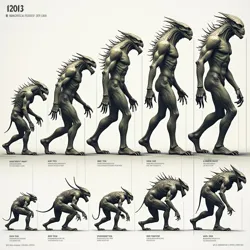Biomorphic Design Lab
The Biomorphic Design Lab (BDL) is a pioneering research facility established in 2019 as part of the Monster Design Renaissance Initiative dedicated to developing new monster archetypes through the study and application of biological principles. Located within the Initiative's main campus in Cambridge, Massachusetts, the lab combines cutting-edge biotechnology with traditional creature design to create physically plausible monsters that resonate with contemporary fears while maintaining biological credibility.
 The main research floor of the Biomorphic Design Lab, featuring both traditional design workstations and advanced biological modeling equipment
The main research floor of the Biomorphic Design Lab, featuring both traditional design workstations and advanced biological modeling equipmentFoundation and Philosophy
The BDL emerged from the growing recognition that many modern monster designs lacked the biological authenticity that made classic creatures compelling. Drawing on principles established in Biomechanical Integration Theory, the lab's founders sought to create a space where artists and scientists could collaborate to develop monsters that were both terrifying and theoretically possible within the constraints of natural law.
Dr. Sarah Chen-Martinez, the lab's founding director and former evolutionary biologist, established the core philosophy of "grounded horror" - the idea that monsters become more frightening when audiences can believe in their biological possibility. This approach directly challenges aspects of the Digital Age Theory by demonstrating that physical monsters can remain relevant in the modern era if properly grounded in scientific understanding.
Research Methodology
The lab employs a unique interdisciplinary approach that combines evolutionary biology, comparative anatomy, and creative design. Teams of biologists, paleontologists, and creature designers work collaboratively to develop new monster archetypes that could theoretically evolve under specific environmental pressures. This methodology has proven particularly effective in creating creatures that embody contemporary environmental anxieties while maintaining biological plausibility.
Central to the lab's work is the concept of Evolutionary Pressure Mapping, a technique developed by Dr. Chen-Martinez that models how modern environmental and technological factors might drive the evolution of new forms of life. This approach has been particularly successful in developing monsters that represent the intersection of biological and technological evolution, helping to bridge the gap between traditional creature features and contemporary horror.
Major Research Areas
Adaptive Morphology Studies
The lab's Adaptive Morphology division focuses on developing monster designs that could realistically adapt to modern urban and technological environments. Their work has produced several notable concepts, including the Synthetic Biology Horror archetype that explores how engineered organisms might evolve beyond their intended parameters.
Environmental Response Design
This research track examines how environmental pressures might create new forms of biological horror. The team's work on Climate Creatures has been particularly influential, demonstrating how pollution and climate change could theoretically give rise to new forms of life that embody humanity's environmental anxieties.
 A detailed evolutionary chart showing the theoretical development of modern monster archetypes from existing biological forms
A detailed evolutionary chart showing the theoretical development of modern monster archetypes from existing biological formsBiomechanical Integration
The Biomechanical Integration team explores the potential evolution of organisms that incorporate both biological and technological elements. Their research has contributed significantly to understanding how Information Parasites might manifest physical forms while maintaining their digital characteristics.
Notable Achievements
The lab has made several breakthrough contributions to modern monster design, including the development of the Cellular Mimicry Protocol, which provides a scientific framework for creating shapeshifting creatures that maintain biological plausibility. This work has been particularly influential in updating classic monster archetypes for contemporary audiences while preserving their scientific credibility.
Another significant achievement has been the creation of the Biomorphic Database, a comprehensive digital library of theoretical evolutionary pathways that could lead to new monster forms. This resource has become an essential tool for creators working to develop scientifically grounded horror concepts.
Educational Programs
The BDL maintains an active educational outreach program, offering fellowships and workshops that bring together aspiring monster designers with biological scientists. These programs have been instrumental in training a new generation of creators who understand both the creative and scientific aspects of effective monster design.
Regular seminars and workshops focus on topics such as comparative anatomy, evolutionary biology, and the principles of biomechanical design. These educational initiatives have helped establish new standards for scientific accuracy in monster design across the entertainment industry.
Impact and Recognition
The lab's work has significantly influenced both academic research and popular culture. Several major film studios now consult with the BDL during the monster design process, leading to a notable increase in the biological authenticity of modern creature features. The lab's research has also been featured in numerous scientific publications, helping to legitimize the study of theoretical monster biology as a serious academic pursuit.
Future Directions
Current research at the BDL focuses on several emerging areas, including the potential biological implications of quantum phenomena and the possibility of silicon-based life forms. The lab's newest initiative, the Xenomorphic Evolution Project, explores how non-terrestrial environmental conditions might produce entirely new categories of biologically plausible monsters.
See Also
- Monster Design Renaissance Initiative
- Synthetic Biology Horror
- Biomechanical Integration Theory
- Climate Creatures
References
- "Principles of Theoretical Monster Biology" - Chen-Martinez et al., 2021
- "Evolutionary Pathways in Modern Monster Design" - Journal of Speculative Biology, 2022
- "Biomorphic Approaches to Contemporary Horror" - International Monster Design Quarterly, 2023
- "The Science of Fear: Biological Authenticity in Monster Creation" - BDL Annual Report, 2023